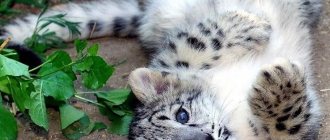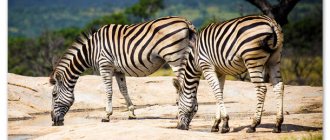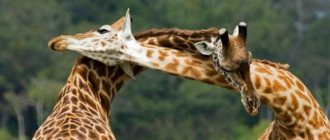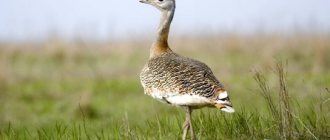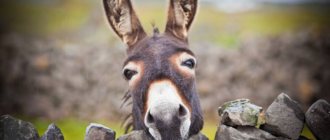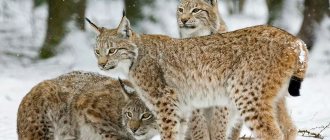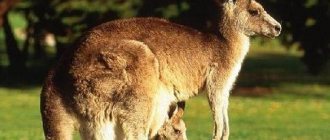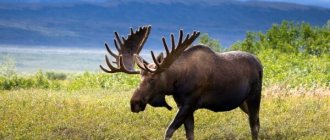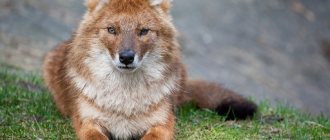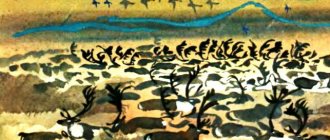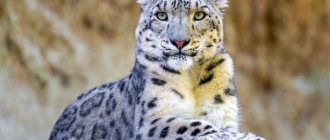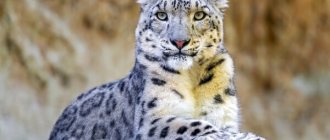The snow leopard or snow leopard is one of the most beautiful representatives of predators, which chose the mountains as its natural habitat. Habits, color - everything about this animal is beautiful, which, in fact, played a cruel joke. Humanity, for the purposes of fishing and profit, at one time almost completely exterminated this animal. At the moment, the snow leopard is included in the Red Book and is under strict protection.
Appearance
In appearance, the snow leopard is very similar to the Far Eastern leopard. However, the main difference is the fur of the snow leopard - it is longer and softer. The tail is also quite long - almost like the body. The fur color is brownish-gray, with ring-shaped spots along the entire back. The length of the snow leopard is about 170 centimeters, and its weight ranges from 50-70 kilograms. It should be noted that males are always heavier and larger than females.
The snow leopard does not change its color depending on the territory where it lives, unlike other predators. However, some scientists state that there are several subspecies, which are distinguished by fur shade and size. But there is still no exact data on this matter.
Snow leopard conservation
In 2010, the Irbis - Snow Leopard program was launched in Russia. The northern border of the snow leopard's range runs through the territories of the south of the Krasnoyarsk Territory, the republics of Tyva, Khakassia, Altai, and Buryatia. All regions have nature reserves, national parks, and wildlife sanctuaries where camera traps are installed, and specialists conduct raids to collect poachers' snares. A system for paying compensation for livestock killed by snow leopard attacks has been developed; livestock pens are being strengthened and open window openings are covered with metal mesh.
Based on the results of the leopard census in 2022, the presence of 70–90 individuals of different ages on Russian territory was proven.
There are agreements on restoring the snow leopard population with Kazakhstan, China, and Mongolia.
The snow leopard is listed as an endangered species on the IUCN Red List. In 2017, it was removed from the list and assigned a new status - vulnerable species. There are almost 7,500 individuals of the rare animal in Asia and Russia.
Conservation of the species
Today, the territories where this predator lives are under strict protection. But, despite such events, there are still hunters and herders who kill animals just to get fur.
In addition, in its natural habitat, also with human help, quite a lot of threats have appeared for the animal. For example, environmental degradation in nature, which is caused by the development of the mining and extractive industries. In addition, the decrease in the number of species is extremely negatively affected by the decrease in food items.
According to statistics, in the period from 2002 to 2016 alone, the number of this animal in Russia decreased by almost three times. However, there is also a positive thing - thanks to the implementation of some environmental protection projects, the population of the predator has recently begun to grow. Thus, the situation has improved significantly due to the opening of the Sailyugem National Park. The protected area is located in Altai.
The threat of extinction of the species is also due to the fact that due to negative circumstances (shooting, poor ecology, lack of food) the number of females has significantly decreased. At the moment, they live only in some areas, and therefore the reproduction of the species still remains under threat.
Snow leopard reserves
In reserves organized to restore the snow leopard population, the animals that the leopard hunts are studied and protected. These are the Siberian mountain goat, argali, Altai mountain sheep, roe deer, maral, and reindeer.
These animals are the target of poachers, so preventing their shooting is an important task for foresters.
Rice. 3. Siberian Kandyk.
Reproduction
Unlike its relatives from the family of predators, the snow leopard reproduces quite slowly, and in one pregnancy the female gives birth to no more than three kittens.
The mating season for this animal begins in the spring - the male attracts the female by purring (you can’t take away their cat habits). After the female is fertilized, the male leaves her. In the future, the parent still takes care of his offspring and quite often they go hunting with the whole family.
Pregnancy lasts 95-110 days. Before the start of labor, the female sets up a den for herself in a secluded place, which will be completely protected from strangers. It is noteworthy that the expectant mother lines the floor in her home with her own wool - she simply rips out shreds.
Kittens are born weighing about half a kilogram, completely deaf and blind. For the first month of life, they feed exclusively on mother's milk. In the fishery, the mother walks only for short periods of time when the newborns are sleeping. Around the middle of the season, the babies are old enough to go hunting with their mother. They become fully mature, and therefore capable of reproduction, in the 2-3rd year of life.
Popular message topics
- What is pattern weaving?
At all times, girls were proud of their dresses, which were decorated with fantastically beautiful patterns. Initially, all the patterns were embroidered by hand, and after a while, to make the work easier, they began to use a loom. This is how patterned weaving arose. - What pollutes the air
Air is an integral part for the existence of all living things. Without him, everything will perish. It contains carbon dioxide, oxygen and nitrogen. But many factors often influence oxygen pollution. These processes can be divided into two types, - Marco Polo
Marco Polo, the first great traveler, who, unafraid of the difficulties and illnesses that lay ahead on his way, set out in search of a trade route to China. Marco Polo was the son of a Venetian merchant who traded with his brother
Habitat
As mentioned earlier, the snow leopard is the only species of predator that lives only in the mountains. The snow leopard makes its lair in caves, rock crevices and similar places.
It should be noted that the animal leads a rather remote lifestyle, although females raise and care for their children for quite a long time. Up to three females can live on the territory of one male at the same time, and this number is considered optimal. At the moment, this proportion, unfortunately, is not respected.
It is noteworthy that the owner of the territory can walk around his territory several times a day, and only along the same route. He marks her in various ways, and quickly removes unwanted guests from his possessions.
It should be noted that, despite its menacing appearance, the snow leopard is quite friendly. He will not engage in battle unless there is a compelling reason to do so. The animal is quite trainable; tamed predators readily contact humans.
In the wild, the snow leopard does not pose a direct threat - if it notices a person, it will simply leave. But, during particularly hungry times, cases of attacks were recorded for the animal.
Snow leopard: description
The animal, which lives high in the mountains of Central Asia, is also called the snow leopard or snow leopard. The name snow leopard comes from Turkic hunters, and was borrowed by Russian merchants back in the 17th century. Only 100 years later did Europeans learn about the existence of this beast. This happened in 1761, when Georges Buffon presented a drawing of this animal with a note that the snow leopard was trained in order to participate in the hunt. It was also indicated here that the animal is found in Persia.
In 1775, a scientific description of the snow leopard was published, presented by the scientist naturalist Johann Schreber. After this, for many centuries, the snow leopard was studied by many zoologists and travelers, including Nikolai Przhevalsky. According to some paleogeneticists, this animal belongs to an ancient species that appeared on planet Earth almost one and a half million years ago.
Appearance
The snow leopard is an impressively sized cat, somewhat reminiscent of a leopard, but not as large in size and more squat. There are a number of other signs that allow you to distinguish a leopard from a leopard: the snow leopard’s tail reaches ¾ of the body length, and the coat is dotted with patterns in the form of rosettes and spots. Adult snow leopards grow up to 2 and a half meters in length, including their tail. The height of the predator at the withers reaches 60 centimeters. Males are heavier, about 55 kg, compared to females, whose weight is no more than 40 kilograms. The head of this animal is round and not large, with the same round and short ears. There are no tufts on the ears, like lynxes, and in winter, due to the thick fur, the ears are practically invisible.
The predator has quite expressive eyes, the color of which matches the color of the fur and whiskers, up to 10 cm long. The legs of the snow leopard are relatively short, and the paws are wide and massive, armed with retractable claws. The tracks left by this predator are round in shape and without claw marks. The tail looks somewhat thicker than it actually is due to the high and thick fur. Thanks to its long tail, the predator can easily maintain its balance while moving in such difficult mountain conditions.
Interesting to know! Snow leopard fur is incredibly thick and soft to the touch. Thanks to this quality of wool, the animal manages to survive in such harsh conditions. The density of the coat is the same as that of ordinary cats, which is considered very unique.
The color of the coat in the back area, as well as the upper areas of the sides, is distinguished by a light gray shade, turning more into white, while the color of the belly and thick parts of the limbs, as well as the lower areas of the sides, is lighter. The unique pattern consists of large round rosettes, as well as solid spots, also round, in black or dark gray. The smallest spots are located on the head of the predator, and larger ones adorn the neck and legs. Closer to the back of the back, the spots seem to merge and form peculiar stripes located along the back. The second half of the tail is characterized by the fact that the spots also merge and form a wide, incomplete ring, while the tip of the tail is always black.
The animal's winter coat has a grayish tint with a smoky touch, which is more typical on the back and sides. Sometimes there is a slight yellowish tint. Thanks to this body color, the snow leopard is easily camouflaged among snow, ice and rocks. With the arrival of summer, the snow leopard's fur color becomes almost white, so the dark spots become more noticeable.
Adult individuals, and especially older ones, do not have such bright fur as their younger relatives.
Behavior and lifestyle
This is an animal that is tied to territory and prefers to lead a solitary lifestyle. Groups of animals can only be seen when females are engaged in feeding and raising their offspring. Each adult individual has its own section of territory, ranging from 15 to 200 square km. The border of each individual is marked with a special secret, although snow leopards do not try to defend it in fights. The snow leopard goes hunting either early in the morning or at dusk and rarely during the daytime. These animals, living in the Himalayas, hunt exclusively in twilight conditions.
During the daytime, the cat rests on the rocks, and it can use the same den for many years. For a den, the snow leopard looks for suitable places, using rock crevices or caves, as well as rocky placers, preferring places located under overhanging stone slabs. There is evidence that some hunters have seen snow leopards in the Kyrgyz Alatau, which have chosen the nests of black vultures.
Interesting moment! The animal regularly walks around its territory, appearing in pastures or camps of wild ungulates, while adhering to the same route. As a rule, the snow leopard trail runs along a mountain ridge or along a river or mountain stream.
Since the territory controlled by the predator is quite large, it takes several days to walk around it. Therefore, a snow leopard appears at one point quite rarely. In addition, due to deep and loose snow, the animal cannot move quickly. Because of this, the snow leopard always prefers to stick to the same route.
SNOW LEOPARD IRBIS - INTERESTING FACTS
How long do snow leopards live?
Living in natural conditions, the snow leopard lives on average about 13 years. If an animal is kept in artificial conditions, then its life expectancy is almost 2 times longer. In zoological parks, snow leopards live for about 21 years, although there is a known case where a female snow leopard lived in captivity for 28 years.
Natural habitats
The habitat of the snow leopard extends exclusively to the mountainous regions of Central and South Asia, the area of which is about 1.23 million square kilometers. Therefore, the snow leopard can be found in the following countries:
- In Russia and Mongolia.
- In Kyrgyzstan and Kazakhstan.
- In Uzbekistan and Tajikistan.
- In Pakistan and Nepal.
- In China and Afghanistan.
- In India, Myanmar and Bhutan.
If you look at the geographical distribution of the habitats of this predator, then the habitat begins in the east of Afghanistan, as well as within the Syr Darya and passes through the Altai, Tannu-Ola, Sayan Mountains, crossing the Pamirs, Tien Shan, Himalayas, Kashmir, etc. In Tibet, the snow leopard lives up to the northern borders of Altushan, and in Mongolia - within the Mongolian-Gobi Altai.
Important fact! Russia is home to no more than 3 percent of the total number of these predators, which are distributed over an area of about 60 thousand square kilometers. The snow leopard in Russia represents the northern and northwestern boundaries of the snow leopard's habitat.
The snow leopard prefers high mountains and eternal snow, choosing to live in areas located on open plateaus, on gentle or steep slopes, as well as in small valleys covered with alpine vegetation, as well as with piles of stones and rocky gorges. Often the snow leopard can be found on flatter areas, with bushes and rocky terrain, where the predator can hide without problems. These animals are more common on the border located above forested areas, although from time to time they also appear in forested areas, especially in winter.
What does it eat?
The snow leopard can attack prey that is three times heavier than itself and easily deals with it. In the wild, this predator hunts the following ungulates:
- On horned and Siberian mountain goats.
- For argali.
- On blue rams.
- For takins and tara.
- On argali and gorals.
- For musk deer and deer.
- For serow and roe deer.
- For wild boars and deer.
With a shortage of wild ungulates, the snow leopard begins to hunt smaller animals such as ground squirrels and pikas, as well as birds such as pheasants, snowcocks and chukars. If necessary, this predator can easily cope with a brown bear, and can also hunt domestic animals such as goats, sheep, horses, etc.
Interesting to know! An adult animal can eat up to 3 kg of meat at one time. With the onset of summer, the predator begins to consume various grasses or young shoots. A predator needs fresh greens to improve the functioning of the digestive system; moreover, this is how predators replenish their bodies with vitamins and minerals.
As a rule, this animal prefers to hunt alone, hiding not far from watering places, salt licks and trails. The snow leopard pounces on its prey from above, from the rocks, or quietly creeps as close as possible.
Closer to autumn, and also with the onset of winter, the female goes hunting with her offspring. The predator attacks its potential prey from a distance of several jumps. If the attack is unsuccessful and the victim manages to escape, the snow leopard never pursues it for more than 3 hundred meters.
As a rule, the snow leopard grabs the animal by the throat, after which it strangles and breaks the neck. After this, he drags the animal’s carcass to a safe shelter where he can eat in peace. Having eaten, the predator can abandon the prey, or it can stay next to it, driving away everyone who wants to dine in the same way.
Reproduction and offspring
It is very difficult to study the life activities of the snow leopard in natural conditions. The fact is that the density of these predators is quite low, and, moreover, the living conditions of these animals do not allow them to fully monitor their life cycles. In this regard, even today researchers do not have all the information about these animals, including some aspects of their reproductive capabilities. The breeding season for predators begins with the arrival of spring. During this period, the males begin to make some sounds that resemble a loud bass meow.
The female does not mate every year, but approximately once every 2 years. Pregnancy lasts from 3 to 4 months. The female sets up her den in the most inaccessible places. After mating, the male leaves the female, entrusting all the care of feeding and raising the future offspring to her. Offspring appear in April/May/June, depending on natural conditions.
Important fact! As a rule, a female gives birth to no more than 3 kittens, although there is information that there can be up to 7 cubs in a litter, although this happens quite rarely. The kittens that are born are blind, helpless, and their body is covered with thick fur, brownish in color, with solid spots, dark in color. The length of newborns can be up to 30 cm, with a weight of about 0.5 kilograms. After about a week or a little more, their eyes open and they begin to see. However, only after a couple of months they begin to leave the den, crawling out. From this moment on, meat begins to appear in their diet, and not just milk.
After a month, the kittens follow their mother completely independently, and already at six months they take part in the hunt. From this period, the juveniles begin to learn the basics of hunting, so they all watch for the prey together, but the decisive throw remains with the mother. The offspring will be fully independent only a year later, next spring. Individuals become sexually mature no earlier than after 3 or 4 years of life.
Natural enemies
The snow leopard has no natural enemies other than humans, since this predator lives in places inaccessible to other predators. In addition, the snow leopard has no competitors and is at the top of the food pyramid. Thanks to such isolation, the animal is protected from incredible enemies, including humans.
How to hunt
Snow leopards prefer to live and hunt alone. Female cats live with their cubs for up to two years. Each animal outlines its territory, marking it. Plot sizes vary from 15 to 190 sq. m. km. Wild cats settle in mountain crevices or under overhanging rocky outcroppings. During the day they lie down in their dens, and at dawn or before sunset they go hunting.
The snow leopard has the habit of periodically inspecting its territory, identifying new ungulate pastures and places where they gather. Having discovered prey, it lies in ambush, trying to take a position above the intended victim. As soon as the distance is reduced to a few of its jumps, the predator jumps out of cover and overtakes its prey by jumping.
He jumps deftly, never stumbling, as if his paws fall between stones and crevices on a steep slope. He tries to grab the victim by the throat and immediately break her cervical vertebrae. If the ungulate breaks free and runs away, the snow leopard may stop, lose interest in it and stop pursuing it.
The snow leopard is a carnivorous animal; it needs to eat 2-3 kilograms of meat every day. In Russia, the snow leopard hunts for ungulates that are found in the mountains of Altai and other regions. If it is not possible to profit from large prey, the predator will not disdain rodents and birds. A hungry animal is capable of attacking a brown bear and attacking domestic animals.
Origin of the species and description
Photo: Snow Leopard
Snow leopards are representatives of predatory mammals. They belong to the cat family, separated into the genus and species of snow leopards. The theory of the origin of this amazing and very graceful predator has not yet been formed.
Back at the end of the 16th century, Russian fur traders and artisans heard from Turkic hunters about a mysterious handsome man, whom they called “irbiz”. For the first time, European residents were able to see the strange cat in 1761. Researcher Georges Buffon showed European nobility pictures that depicted a very beautiful wild cat. He supplemented his pictures with information that they are trained and raised to participate in hunting in Persia.
Video: Irbis
Since then, many scientific researchers and zoologists have been interested in this amazing beast. In 1775, the German zoologist-naturalist Johann Schreber wrote an entire scientific work that was devoted to the origin and evolution of animals, as well as a description of their appearance and lifestyle. Subsequently, the Russian scientist Nikolai Przhevalsky also studied the life activity of the snow leopard. A number of scientific, including genetic, examinations were carried out, according to which it was possible to establish that the approximate existence of the feline predator is about one and a half million years.
The first remains of the animal, which by all indications belonged to the snow leopard, were discovered on the western border of Mongolia, in Altai. They are dated to the late Pleistocene period. The next significant find is the remains of an animal in the northern region of Pakistan. Their approximate age is one and a half million years. Initially, snow leopards were classified as panthers. A little later, studies showed that the snow leopard and the panther do not have direct common characteristics.
This representative of the cat family has distinctive features that are not inherent in other representatives of this family. This gives grounds to distinguish them into a separate genus and species. Although today there is no exact information about the origin of the snow leopard genus, scientists are inclined to believe that the snow leopard and the panther did not have common ancestors. The results of genetic testing give reason to believe that they separated into a separate branch a little more than a million years ago.
Behavior and hunting
In summer, the snow leopard prefers to live among rocks and mountain meadows.
In winter it descends into wooded areas. This is approximately 1200 meters above sea level. Snow is not a problem for a predator. It moves well even on snow cover, the depth of which reaches 80 cm. But in most cases, the snow leopard prefers well-trodden paths.
They are made in the snow by ungulates, which are the main prey of the predatory cat.
Each animal hunts strictly within its own territory.
He marks its boundaries with urine and feces. If there is a lot of prey, then the land plots of snow leopards are small. They range from 12 sq. km up to 40 sq. km. If food is tight, then in such areas there are few cats, and their allotments reach up to 200 sq. km.
The snow leopard is active in the early morning and evening twilight hours. It is secretive, camouflaged well, and it is very difficult for the same hunter to meet a predator.
By the way, the snow leopard practically does not attack humans. Over hundreds of years, only isolated cases of such tragedies can be counted. A cat enters into a fight with a person only when it is “driven into a corner” and the animal has nowhere to go.
The cat hunts any living creature, but, as already mentioned, it gives preference to ungulates.
The size of the predator's prey is not frightening. He is very fond of Himalayan blue sheep, Himalayan tahr (wild mountain goat) and markhor (marker goat), which weigh up to 110 kg.
A snow leopard ambushes its prey.
The length of his jumps is 14 meters. Chases prey at a distance of up to 300 meters. If he cannot catch up, he stops the chase. Having caught up with the victim, it bites its neck. The body is dragged to a secluded place. Eats the entire carcass, leaving only the skeleton. A large sheep lasts a snow leopard for two weeks.
In addition to sheep, the snow leopard feasts on gorals, deer, wild boars, langur monkeys, hares, birds, and rodents.
It also eats various herbs, which makes it different from other cats. In times of famine, it eats carrion and attacks livestock, making enemies among people.
Why is the snow leopard listed in the Red Book?
Snow leopards have become very rare animals; only about 6,000 individuals remain in the wild. For a long time, these cats were killed for their valuable skins. There was a period when people launched a fight against rodents - agricultural pests. Then the natural balance was disrupted - small animals disappeared and it became more difficult for leopards to obtain food in winter. Many snow leopards died of hunger at that time.
Serious measures are now being taken to protect snow leopards, but it is very difficult to control their shooting in the highlands, and local residents continue to hunt leopards. It must be said that snow leopards avoid collisions with humans, and there has not been a single case of these cats attacking people.
“Snow Leopard” is the official name of a special token that was awarded when the title “Conqueror of the Highest Mountains of the USSR” was awarded. It was awarded to climbers who reached the largest peaks located on the territory of the former USSR.
The mass extermination of this predator led to a sharp decline in its numbers already before the beginning of the twentieth century. Live snow leopards were very popular, keeping them was a special chic. In addition, for a long time the snow leopard was considered the most dangerous predator, for the destruction of which there was even a bonus, although in relation to humans this animal always behaved with restraint and, one might say, timidly.
According to the Russian representative office of the World Wildlife Fund, in 2003, the number of snow leopards in Russia ranged from 150 to 200 individuals.
How to find out
The snow leopard has a flexible and agile body, relatively short legs and a graceful gait. The length of the body including the tail reaches 230 cm, and the weight is 55 kg. The very beautiful pale-gray coloring of this animal with ring-shaped or solid spots and a general smoky shade of fur give the snow leopard the appearance of an inhabitant of the eternal snows.
In winter, the leopard's fur becomes thicker and acquires a very beautiful color. Even the paw pads are covered with hair, which helps him move through the snow. This wonderful animal is mercilessly destroyed by hunters because of its beautiful fur, and therefore it is currently on the verge of extinction as a species.
The skin helps the animal to remain unnoticed among rocks, stones and white snow. The fur is soft and long, can reach 55 mm. The snow leopard's tail, which exceeds almost three-quarters of the total body length, is covered with particularly long hairs. This is what makes him appear very thick.
Interestingly, the snow leopard has some characteristics of both large and small cats. For example, he does not know how to growl at all. It tears apart prey like the former, and eats like the latter. Snow leopards are excellent jumpers. When attacking, the jump length reaches 13 m.
Lifestyle and biology
Snow leopards lead a solitary lifestyle. True, a devoted and caring female snow leopard does not part with her kittens for a long time, sometimes up to three or four years, preparing them for “adult” life. Kittens are born up to twice a year, preceded by a gestation period of 90 to 110 days. The female raises the baby herself.
The image of the snow leopard has been used by various peoples since ancient times. The snow leopard is the official symbol of Almaty. It is the snow leopard that is depicted on the coat of arms of this city, as well as on the coat of arms of the city of Bishkek, the capital of the Kyrgyz Republic. In addition, the winged snow leopard is depicted on the coats of arms of Tatarstan and Khakassia.
To be fair, it should be said that males are not aggressive towards their fellow tribesmen; they can share the territory with several adult females. The snow leopard regularly walks around its property, following the same routes. In a certain place it can be found once every few days.
The main food of the snow leopard is wild ungulates. He enjoys hunting blue and wild sheep, marking goats and argali. If the snow leopard misses when jumping, it pursues the prey at a distance of no more than 300 m or even leaves it alone. The maximum known lifespan of a leopard is 28 years, the average is 13 years.
In summer, the leopard goes high into the mountains in search of marmots and other small mammals. At this time, you can also feast on wild sheep lambs. This is an easy prey for a leopard. Severe cold and deep snow drive him down into the valleys during harsh winters, where the leopard attacks domestic animals.
The majestic snow leopard is rarely seen as it lives high in the Himalayas and rarely leaves the snow-capped mountains. Despite the fact that this animal is on the verge of extinction, it is nevertheless hunted for its wonderful fur by hunters, and by farmers because it attacks livestock.
Literature (source): Red Book of the Russian Federation. IUCN Red List - https://www.iucnredlist.org/details/22732/0
Character and features
The snow leopard leads a solitary lifestyle. The only exception is females raising their grown cubs. The predator strictly adheres to the boundaries of its own territory, marking it with smell and claw marks. A male's territory may overlap with the territories of several females. If other individuals enter the territory of a snow leopard, the animal does not show aggression, regardless of gender. The size of an individual territory depends on the amount of prey, and ranges from 20 to 200 square kilometers.
The predator regularly makes detours around its territory, and chooses the same route. The detour includes pastures and watering places for ungulates. When walking, the animal prefers to move along river beds or along mountain ranges. Due to the significant length of the route, the snow leopard visits the same place only once every few days. A stable route makes the animal more vulnerable to poachers.
The snow leopard does not move well on high, loose snow, so in winter the predator either tramples permanent snow paths or moves to places with lower snow cover.
The snow leopard is active mainly at dusk, hunting more often before sunset and at dawn. During the day the animal rests and sleeps. As a lair, it usually chooses small caves, crevices in rocks, depressions in rocky piles, secluded places under an overhanging slab. A snow leopard can use the same den for several years.
